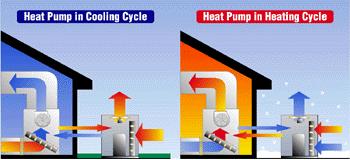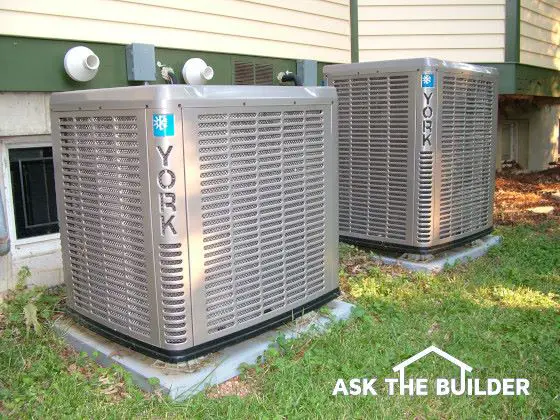Heat Pump Facts
Heat Pump Illustrations and Facts
Heat pumps are very popular machines. They appeal to many land developers and builders because they are relatively easy to install. Since electricity is already being extended into the subdivision and your home, there is no real extra utility costs. Installing natural gas lines and service is an extra step for a developer and a builder. Heat pumps don't require masonry chimneys for that matter. Do you see why they were easy to market to builders and developers?
Not an Easy Machine
Heat pumps may be easy to market and install, but they are by no means a simple machine. In fact, they are by far the most complicated machine that you will find in the average residential home. The controls, actual machinery, components, etc. are highly complex and require professional attention. They are by no means a do-it-yourself project. In fact, even people who work around them on a routine basis can make mistakes. Just ask my brother-in-law! He regularly helps and assists my heating contractor. One day, my brother-in-law thought he would take pressure readings on the outdoor compressor at his parent's home. Well, before you could say, "Watch what you are doing.", he lost all of the refrigerant out of the machine. I guess he wanted to do his part to increase the size of the ozone hole over the South Pole.
The Heat Pump Coil
Standard air conditioners have two coils. One distributes cooling and the other one disposes of collected heat. One of these coils is hidden inside your home in the furnace or air handler unit where the fan is located. The other coil is outdoors in the big metal contraption. Heat pump coils need to be designed a little differently because they have to serve both purposes. In other words, when the pump switches from heating to cooling, the tasks of the coils switch as well.
High Efficiency
How do heat pumps become more energy efficient? There are several primary ways. One of the most practical things to do is to increase the size or surface area of the indoor and outdoor coils. This will definitely help move heat one direction or another faster.
Heat pump manufactures are also re-introducing the expansion valve. This used to be standard equipment on air conditioners and heat pumps years ago. An expansion valve meters the flow of refrigerant. Because the internal pressure of the refrigerant in the system changed with a rise or fall in outdoor air temperature, metering the flow of Freon delivers just the right amount of heating or cooling to the living space. Prior to the re-introduction of expansion valves, a fixed orifice in the refrigerant system was used to regulate the flow of refrigerant.
Efficiency can also be improved by moderating the flow of air across the coils. You can do this by installing two speed fans or variable speed fans that sense when to move more or less air across the coils.
The Defrost Mode
When the air temperature drops below 32 degrees outside and the outside air is fairly saturated with humidity, frost can form on the outdoor unit coils. This is perfectly natural. The frost can turn to a thin layer of ice rather quickly during periods of operation.
The most efficient heat pumps have sensors that tell the heat pump that ice is forming. When the sense ice, they actually send heat back outdoors to melt the ice. Less efficient heat pump models do this on a time and temperature basis and may send heat to the outdoor coil when it isn't necessary to do so. If this happens, you have to pay more to heat the house back up! Ask about this feature when you shop for a heat pump.
Heat Pump Thermostat
Don't by just any thermostat for your heat pump system. Heat pumps require special thermostats. These instruments separate the two heating functions found in all heat pumps: the heat pump aspect and the auxiliary electric resistance heat. Wiring a heat pump thermostat is different and don't attempt to do it yourself. You can easily short out the device and ruin the sensitive electronic components inside the thermostat. Just ask my brother-in-law. He has burned up at least one or two of these as well.
Heat pump thermostats have a little light that tells you when the heat pump is using electric resistance heat. If you see this light on when the outdoor temperature is 40 F or higher, something is possible wrong with your unit or the thermostat. Call a qualified service person as soon as possible and have them check out all components. Electric resistance heat is very expensive and you can lose all of your energy savings in a short time if you rely solely on electric resistance coils to supply heat to your home.
Heat Pump Mechanics - Some Simple Facts
Just what is inside that big metal box/contraption on the exterior of your home? Let me tell you, it is a highly sophisticated machine. In fact, heating and air conditioning are by far the most complex craft in home building and remodeling.

Cutaway illustration of a typical heat pump.
The image to the right is a cut-away illustration of a typical modern heat pump. The heart of the heat pump is the high-efficiency scroll compressor. It takes the gaseous refrigerant and turns it into a liquid. The heat pump also contains high and low-pressure switches, accumulators, a filter drier, discharge temperature switches, mufflers, vibration isolation plates, a high-efficiency fan to move air past the outdoor coil, and all sorts of wiring and copper tubing. They are complicated beasts to say the very least! Be sure you have a professional service or install yours!
Three Types of Machines

A heat pump is not much different than a car with a transmission. You can go forward or reverse in a car. Flip the switch at your thermostat and the same thing happens within the heat pump.
The heat pump shown in the illustration to the left is the most common machine. It transfers heat from one body of air to another - an air to air transfer. Did you know that there are two other types of heat pumps? You bet! You can actually get a heat pump that takes heat from a body of water or from the earth itself. These are called water to air and ground to air transfer machines. The principles of operation are the same in all three. The water to air and ground to air heat pumps are actually more efficient if you have the ability to extract or dispose of heat from/into a body of water or the ground that has a nearly constant temperature of 55 F.
If you’re interested in learning more about prices for heat pumps I have an article here.
Column B294

2 Responses to Heat Pump Facts